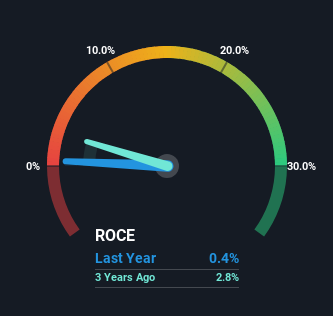- United States
- /
- Telecom Services and Carriers
- /
- NasdaqGS:LBTY.A
Investors Could Be Concerned With Liberty Global's (NASDAQ:LBTY.A) Returns On Capital

What underlying fundamental trends can indicate that a company might be in decline? Businesses in decline often have two underlying trends, firstly, a declining return on capital employed (ROCE) and a declining base of capital employed. Ultimately this means that the company is earning less per dollar invested and on top of that, it's shrinking its base of capital employed. So after we looked into Liberty Global (NASDAQ:LBTY.A), the trends above didn't look too great.
What Is Return On Capital Employed (ROCE)?
Just to clarify if you're unsure, ROCE is a metric for evaluating how much pre-tax income (in percentage terms) a company earns on the capital invested in its business. The formula for this calculation on Liberty Global is:
Return on Capital Employed = Earnings Before Interest and Tax (EBIT) ÷ (Total Assets - Current Liabilities)
0.0045 = US$179m ÷ (US$44b - US$3.7b) (Based on the trailing twelve months to March 2023).
Thus, Liberty Global has an ROCE of 0.4%. In absolute terms, that's a low return and it also under-performs the Telecom industry average of 6.8%.
Check out our latest analysis for Liberty Global

In the above chart we have measured Liberty Global's prior ROCE against its prior performance, but the future is arguably more important. If you'd like, you can check out the forecasts from the analysts covering Liberty Global here for free.
What Can We Tell From Liberty Global's ROCE Trend?
There is reason to be cautious about Liberty Global, given the returns are trending downwards. Unfortunately the returns on capital have diminished from the 1.8% that they were earning five years ago. And on the capital employed front, the business is utilizing roughly the same amount of capital as it was back then. Since returns are falling and the business has the same amount of assets employed, this can suggest it's a mature business that hasn't had much growth in the last five years. If these trends continue, we wouldn't expect Liberty Global to turn into a multi-bagger.
The Key Takeaway
In the end, the trend of lower returns on the same amount of capital isn't typically an indication that we're looking at a growth stock. It should come as no surprise then that the stock has fallen 30% over the last five years, so it looks like investors are recognizing these changes. That being the case, unless the underlying trends revert to a more positive trajectory, we'd consider looking elsewhere.
On a separate note, we've found 1 warning sign for Liberty Global you'll probably want to know about.
While Liberty Global may not currently earn the highest returns, we've compiled a list of companies that currently earn more than 25% return on equity. Check out this free list here.
New: AI Stock Screener & Alerts
Our new AI Stock Screener scans the market every day to uncover opportunities.
• Dividend Powerhouses (3%+ Yield)
• Undervalued Small Caps with Insider Buying
• High growth Tech and AI Companies
Or build your own from over 50 metrics.
Have feedback on this article? Concerned about the content? Get in touch with us directly. Alternatively, email editorial-team (at) simplywallst.com.
This article by Simply Wall St is general in nature. We provide commentary based on historical data and analyst forecasts only using an unbiased methodology and our articles are not intended to be financial advice. It does not constitute a recommendation to buy or sell any stock, and does not take account of your objectives, or your financial situation. We aim to bring you long-term focused analysis driven by fundamental data. Note that our analysis may not factor in the latest price-sensitive company announcements or qualitative material. Simply Wall St has no position in any stocks mentioned.
About NasdaqGS:LBTY.A
Liberty Global
Provides broadband internet, video, fixed-line telephony, and mobile communications services to residential and business customers.
Undervalued low.
Similar Companies
Market Insights
Community Narratives



